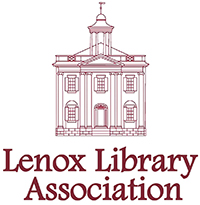The extensive and varied Special Collections held by the Library range from Colonial Era manuscripts, legal documents and publications through original photographic prints and glass plate negatives to illustrated and annotated early 18th and 19th century volumes, including literary first editions and art and children’s books.
These unique, fragile materials, while they provide broad and revealing views of the historical development of Lenox and the surrounding area, are not limited to regional interests. The presence and participation of significant figures such as Nathaniel Hawthorne, Edith Wharton, Andrew Carnegie, Leonard Bernstein and others in Lenox life and activities lend the Special Collections importance and value that transcend the Berkshires. As such, these materials are consulted by scholars, researchers and students from throughout the country. At the same time, the Special Collections are also heavily used by new and local residents seeking to gain a sense of place and understanding of their home.
For more information concerning these collections, please contact Local History Librarian Amy Lafave at alafave@lenoxlib.org
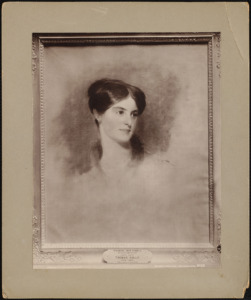 Famed British actress Frances Anne “Fanny” Kemble (1809-1893) was one of Lenox’s most celebrated residents. In her early 20s, she staged an American tour, where she would meet novelist Catharine Maria Sedgwick who introduced her to Lenox. She also met and married Pierce Butler in 1834; Butler would inherit several hundred enslaved persons on an island plantation off the coast of Georgia. When Fanny and Pierce divorced in 1849, Charles Sedgwick (Catharine’s brother) found her a home on the new county road which would subsequently be named in her honor, Kemble Street.
Famed British actress Frances Anne “Fanny” Kemble (1809-1893) was one of Lenox’s most celebrated residents. In her early 20s, she staged an American tour, where she would meet novelist Catharine Maria Sedgwick who introduced her to Lenox. She also met and married Pierce Butler in 1834; Butler would inherit several hundred enslaved persons on an island plantation off the coast of Georgia. When Fanny and Pierce divorced in 1849, Charles Sedgwick (Catharine’s brother) found her a home on the new county road which would subsequently be named in her honor, Kemble Street.
Amelia M. Watson (1856–1934), an illustrator, was fascinated by Kemble’s life. Watson made a pilgrimage in 1915 to the Butler Plantation, where Kemble had written her “Journal of a Residence on a Georgia Plantation.” Watson took photographs of the plantation and former slaves, which she used along with her own watercolor illustrations to create re-bound, unique editions of Kemble’s works, including the Journal. The collection also includes flyers advertising Kemble’s Covent Garden stage career in the early nineteenth century.
This collection is housed in the Keator Vault.
Scope and Content, Biographical Note and Collection Overview
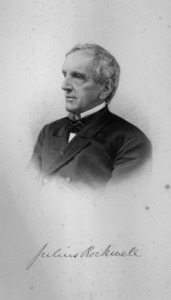 Judge Julius Rockwell (1805-1888) held political office in the Massachusetts House of Representatives and the U.S. House and Senate. Upon its organization in 1859, Rockwell was appointed to the superior court of Massachusetts. His wife Lucy was the daughter of Judge William Perrin Walker; his father, Judge William Walker, had served as a captain in the Revolutionary War. Rockwell’s brother-in-law was David Davis, campaign manager for Abraham Lincoln, who would appoint Davis to the Supreme Court.
Judge Julius Rockwell (1805-1888) held political office in the Massachusetts House of Representatives and the U.S. House and Senate. Upon its organization in 1859, Rockwell was appointed to the superior court of Massachusetts. His wife Lucy was the daughter of Judge William Perrin Walker; his father, Judge William Walker, had served as a captain in the Revolutionary War. Rockwell’s brother-in-law was David Davis, campaign manager for Abraham Lincoln, who would appoint Davis to the Supreme Court.
There is extensive correspondence between Rockwell and his family and friends. Additional letters and documents from the earlier Walker family collection makes this the Library’s most extensive historical collection, encompassing 18th and 19th century local, state and national history.
This collection is housed in the Keator Vault.
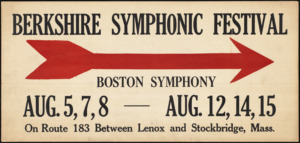 The Tanglewood Papers are historical papers documenting the pre-Tanglewood history of the Berkshire Symphonic Festival and the Berkshire Music Center, as well as the founding of Tanglewood and the building of its music pavilion – “The Shed.”
The Tanglewood Papers are historical papers documenting the pre-Tanglewood history of the Berkshire Symphonic Festival and the Berkshire Music Center, as well as the founding of Tanglewood and the building of its music pavilion – “The Shed.”
The papers are from the estate of well-known summer resident, Gertrude Robinson Smith, whose fundraising efforts resulted in construction of “The Shed.”
This collection is housed in the Keator Vault.
Front side of the document
Reverse side of document
Transcription
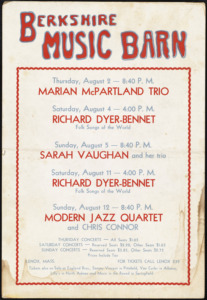 Founded in Lenox by Stephanie and Philip Barber, the Music Inn was a center of jazz performance and education from 1950 to 1960. The Barbers purchased part of the Wheatleigh estate to hold concerts and roundtable discussions. In 1957, the Barbers partnered with Modern Jazz Quartet pianist John Lewis to form the Lenox School of Jazz. The archives contain clipping scrapbooks, posters, brochures, course curricula, as well as reservation forms and menus for guests staying at the Music Inn.
Founded in Lenox by Stephanie and Philip Barber, the Music Inn was a center of jazz performance and education from 1950 to 1960. The Barbers purchased part of the Wheatleigh estate to hold concerts and roundtable discussions. In 1957, the Barbers partnered with Modern Jazz Quartet pianist John Lewis to form the Lenox School of Jazz. The archives contain clipping scrapbooks, posters, brochures, course curricula, as well as reservation forms and menus for guests staying at the Music Inn.
This collection is housed in the Keator Vault.
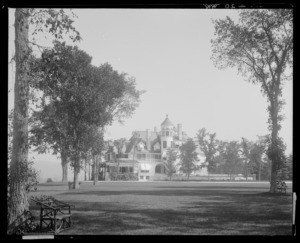 Edwin Hale Lincoln was born in Westminster, Massachusetts in 1848, the son of a Universalist minister. After serving in the Civil War as a drummer boy and a stint as a page in the Massachusetts House of Representatives, Lincoln went into the photographic business in Brockton in 1876. He pioneered photographing yachts under full sail in Newport, Rhode Island and became one of the first photographers to specialize in documenting large estates. He first visited Lenox in 1883 and moved permanently to the area in 1893, just as the Berkshire “Summer Cottages” were reaching their zenith. For the next several decades, Lincoln would capture in remarkable photographs not only the grandeur and scale of the estates but also their fragility and impermanence.
Edwin Hale Lincoln was born in Westminster, Massachusetts in 1848, the son of a Universalist minister. After serving in the Civil War as a drummer boy and a stint as a page in the Massachusetts House of Representatives, Lincoln went into the photographic business in Brockton in 1876. He pioneered photographing yachts under full sail in Newport, Rhode Island and became one of the first photographers to specialize in documenting large estates. He first visited Lenox in 1883 and moved permanently to the area in 1893, just as the Berkshire “Summer Cottages” were reaching their zenith. For the next several decades, Lincoln would capture in remarkable photographs not only the grandeur and scale of the estates but also their fragility and impermanence.
At the same time, Lincoln began a 20 year labor of love – an extensive photographic study of New England wild flowers. In 1914, he published his photographs in a handmade, small-edition folio of platinum prints called Wild Flowers of New England. Lincoln’s wildflower studies were widely used in university botany departments and in schools of fine art. He also made studies of trees, orchids, and landscapes. Lincoln photographed with an 8 x 10 view camera and printed primarily on platinum paper.
The Library’s collection consists of 745 original glass plate and film negatives of the Berkshire estates, as well as a complete set of study prints. In addition, the Library has one of the few remaining sets of Wild Flowers of New England.
This collection is housed in the Keator Vault.
 This collection contains more than 300 original prints dating from the earliest days of the use of the medium in the 19th century. Unlike the Lincoln Collection, the majority of these images capture the full dimensions of life in 19th Century Lenox, ranging from the wealthiest to the most ordinary inhabitants.
This collection contains more than 300 original prints dating from the earliest days of the use of the medium in the 19th century. Unlike the Lincoln Collection, the majority of these images capture the full dimensions of life in 19th Century Lenox, ranging from the wealthiest to the most ordinary inhabitants.
This collection also includes over 200 glass plate negatives. The majority of these images are believed to be the work of Lenox Dale resident Augustus Martin (1872-1961), who documented life in an often neglected section of town.
This collection is housed in the Keator Vault.
This collection is housed in the Legacy Room.
This collection is housed in the Special Collections Room.

